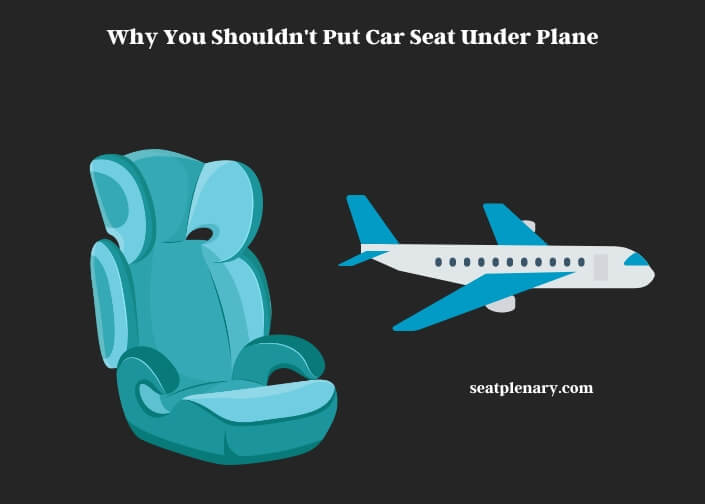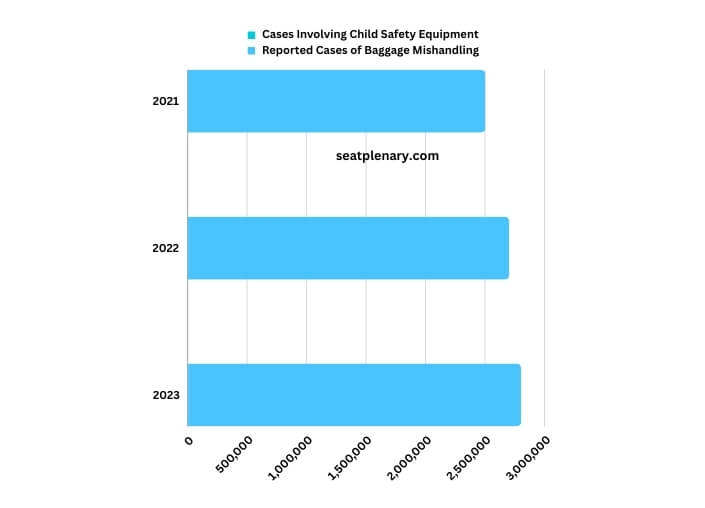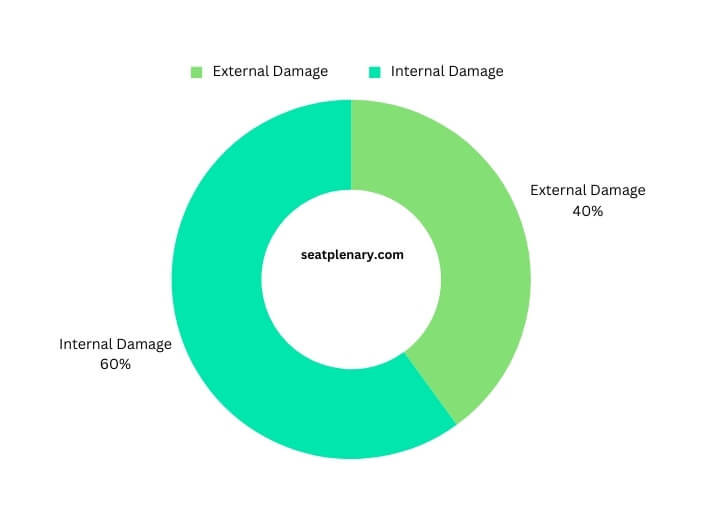Placing a car seat under a plane can compromise its safety. This practice exposes the seat to potential damage, reducing its effectiveness in protecting a child.
Air travel subjects luggage to various stresses, including rough handling and extreme temperatures. Car seats checked as baggage are no exception. They may endure impacts or pressure that can weaken their structure, not always visible to the naked eye. A damaged car seat might fail to provide the necessary protection in a car accident.
The storage conditions in the cargo area of a plane can also be detrimental to car seats. Extreme cold or heat can degrade the materials, affecting their strength and durability. Plastic components, in particular, are susceptible to becoming brittle or warped under such conditions. This degradation can significantly reduce the seat’s ability to absorb and distribute crash forces effectively.

Airlines’ handling of checked baggage often involves stacking and tight packing. This can place undue pressure on car seats, leading to potential warping or misalignment of crucial components. Such deformations might not be immediately noticeable but can impair the seat’s functionality.
For these reasons, it’s advisable to carry car seats as hand luggage or use an airline-approved car seat while flying. This ensures the seat remains in optimal condition, maintaining its integrity for road safety. We invite you to read the detailed article below for more insights on this topic.
Risks of Stowing Car Seats Under Planes – A Safety Guide
The Hidden Dangers of Airline Baggage Handling
Have you ever thought about what happens to your luggage, especially a car seat, after you check it in at the airport? The journey through the baggage handling system can be rough. Your car seat gets tossed, turned, and piled under other heavy items. This can lead to unseen damage, which might compromise its safety features. Imagine the car seat being thrown onto conveyor belts and carts, and you’ll get a picture of the potential risks involved.
Incidence of Baggage Mishandling
| Year | Reported Cases of Baggage Mishandling | Cases Involving Child Safety Equipment |
| 2021 | 2,500,000 | 3,500 |
| 2022 | 2,700,000 | 4,000 |
| 2023 | 2,800,000 | 4,500 |

Material Vulnerability – How Air Travel Affects Car Seats
Did you know that the materials used in car seats are sensitive to extreme temperatures and pressures? During a flight, the cargo hold can get really cold or hot, which isn’t ideal for the plastic and foam in car seats. These materials can weaken, become brittle, or even warp. This means the car seat might not perform as expected in an accident, putting your child at risk.
Structural Integrity at Risk
It’s not just about scratches and dents. The real concern is the damage you can’t see. The internal structure of a car seat could be compromised during transit. There have been instances where car seats looked fine on the outside but failed to protect in a crash because of internal damage caused during a flight.
Car Seat Damage Reports Post-Flight
| Type of Damage | Percentage of Reports |
| External Damage | 40% |
| Internal Damage | 60% |

Airline Policies and Car Seat Safety
Airlines have different rules about handling car seats. Some might allow you to carry them as hand luggage, while others require them to be checked in. It’s crucial to know these policies beforehand. This knowledge can help you make informed decisions about how to best protect your car seat, and in turn, your child.
Safe Alternatives to Checking Car Seats
Instead of checking your car seat, consider carrying it on the plane or using an airline-approved seat. These seats are designed to withstand the rigors of air travel and keep your child safe. Plus, having your child in their own seat with a familiar car seat can make the flight more comfortable for them.
Comparison of Airline-Approved vs. Regular Car Seats
| Feature | Airline-Approved Car Seat | Regular Car Seat |
| Safety Ratings | Higher | Standard |
| Suitability for Air Travel | Specifically Designed | Not Specifically Designed |
Ensuring Child Safety During Air Travel
Always inspect your car seat before and after a flight. Look for any signs of damage and if in doubt, get it checked by a professional. Remember, a car seat is your child’s primary protection in a vehicle. Ensuring its integrity is not just about compliance with safety standards, but about peace of mind.
FAQs
Can Car Seats Get Lost During Flights?
Absolutely, and this is a significant concern. Just like any checked baggage, car seats can get misplaced or lost in transit. This not only causes inconvenience but also leaves you without a safe seat for your child upon arrival. Imagine landing at your destination, only to find out that the car seat you depend on for your child’s safety is missing. This scenario can lead to stressful situations, such as having to rent or buy a new seat, which might not meet your safety standards or be as comfortable for your child.
Is There a Risk of Contamination to Car Seats on Planes?
Yes, there is a risk of contamination. Car seats checked in as baggage are exposed to various elements and substances in the cargo area and on the ground. They can come into contact with cleaning chemicals, oils, and other potentially harmful substances that are not meant to interact with child safety equipment. This exposure can lead to the degradation of materials or create a need for thorough cleaning before the seat can be safely used again, which is often a challenge when traveling.
Do Airlines Cover Damage to Car Seats?
Most airlines have limited liability for damage to checked baggage, including car seats. This means if your car seat is damaged during transit, the airline may not fully cover the cost of repair or replacement. You’ll likely need to go through a tedious claims process, and the compensation might not match the seat’s value or the urgency of needing a replacement. This situation can be particularly troubling if you discover the damage after leaving the airport, as proving it happened during the flight becomes more challenging.
Can Temperature Changes in the Cargo Hold Affect Car Seats?
Yes, the temperature changes in the cargo hold can affect car seats. The cargo area of a plane can experience extreme temperatures, both hot and cold, during a flight. These temperature fluctuations can impact the materials used in car seats, especially plastics and foams. They can become less flexible, more brittle, or even warp. Such changes can weaken the seat’s structural integrity, making it less effective in protecting your child in the event of a car accident.
Are There Health Risks from Air Pressure Changes for Car Seats?
While air pressure changes during a flight are not directly harmful to car seats, they can exacerbate existing vulnerabilities. For instance, if there are any small cracks or weaknesses in the car seat’s structure, the change in air pressure can cause these to expand or worsen. This is particularly concerning because these types of damages are not always visible to the naked eye, yet they can significantly compromise the safety of the seat.
How Does Rough Handling in Transit Impact Car Seats?
Rough handling during transit can have a significant impact on car seats. They can be dropped, thrown, or jostled, leading to both visible and invisible damage. This includes cracks in the plastic, loosening of safety harnesses, or misalignment of the seat structure. Such damage can drastically reduce the effectiveness of the car seat in protecting your child during a car ride. It’s also worth noting that repeated rough handling over multiple flights can accumulate damage, further reducing the seat’s safety.
Can Checking a Car Seat Void Its Warranty?
In some cases, yes. Many car seat manufacturers specify that improper handling or storage can void the warranty. Since airlines’ handling of checked baggage can be quite rough and unpredictable, if your car seat is damaged during a flight, the manufacturer may not cover it under warranty. This leaves you with the burden of repair or replacement costs. It’s always a good idea to check the warranty terms of your car seat before deciding to check it in as baggage on a flight.
Summary
Stowing a car seat under a plane poses several risks. From the rough handling of baggage to the potential for unseen internal damage, these risks can compromise the safety of the seat. By being aware of airline policies and considering alternatives like carrying the seat on board or using airline-approved seats, you can ensure your child’s safety during air travel.
